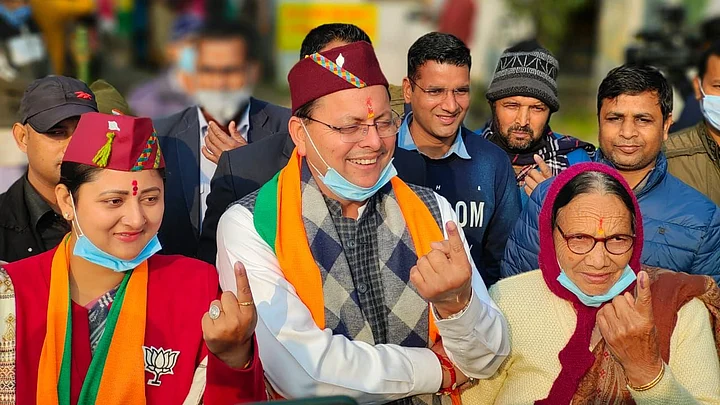With a voter turnout of 60 percent, the polling for the Assembly elections in the state of Uttarakhand concluded on Monday, 14 February. While the state is known to have an average voter turnout, it was lesser this time compared to the previous two elections held in 2017 (64.8 percent) and 2012 (66.6 percent).
While Haridwar saw the highest polling in the state at 68.37 percent followed by 65.13 percent in Udham Singh Nagar, and 65.55 percent in Uttarkashi, polling in Almora was the lowest at 50.65 percent.
What does the low voter turnout across the state and in the key constituencies mean? Does it indicate the mood of the voters?
Polling in Kumaon and Garhwal
The Kumaon region consists of six districts with Nainital as zonal headquarters, while Garhwal has seven districts with Pauri Garhwal as headquarters. Dehradun, the capital, is part of Garhwal, which with 41 constituencies is larger than Kumaon with 29.
Here's how the polling fared in key constituencies of Kumaon:
Nainital: 63%
Pithoragarh: 57%
Udham Singh Nagar: 65%
Bageshwar: 57%
Champawat: 56%
Almora: 50%
Here's how the polling fared in key constituencies of Garhwal:
Haridwar: 68.37%
Uttarkashi: 65%
Rudraprayag: 60%
Chamoli: 59%
Dehradun: 52%
Tehri Garhwal: 52%
Pauri Garhwal: 51%
The Muslim Factor in Haridwar
Haridwar district witnessed the highest polling percentage in Uttarakhand at 68.37 percent. The district has 11 assembly segments.
With most popular Hindu religious sites of the state being situated in the Garhwal region, Muslim and minority voters also form a sizeable chunk (34 percent) in Haridwar.
The high poll percentage is being seen as the aftereffect of the controversy stoked up by divisive statements during the recently held Dharma Sansad.
The Caste Equation
The politics of Uttarakhand is dominated by upper-caste voters, with the fight for political supremacy being between the Thakurs and the Brahmins.
The state has around 22 percent of SC-ST voters, but the OBCs do not have much sway in the state like in Uttar Pradesh. According to data, 85 percent of voters are Hindu, of which 60 percent belong to Thakur and Brahmin communities. Interestingly, the state has a high percentage of service voters, mostly servicemen in security forces, at around 30 percent of total voters. In the Kumaon region, SC-ST voters are in sizeable chunks.
The Kumaon region has traditionally been a stronghold of the Congress, with the party having a loyal voter base of over 34 percent in all elections since 2012. While the Congress' voters are largely comprised of OBC, Dalit, and minority voters, the BJP has largely maintained its focus on upper-caste votes. The AAP, however, is looking to eat into the Congress vote bank in Kumaon which in turn benefits the BJP
What Nainital's Voter Turnout Means for Harish Rawat
Former Chief Minister Harish Rawat is fighting this time from the Lalkuan assembly segment in Nainital. Rawat has a considerable influence on assembly seats nearby Udham Singh Nagar district as well.
Nainital saw 63 percent polling on Monday while 65 percent voting was recorded in Udham Singh Nagar.
The higher polling in the area of influence of Rawat indicates that the wind may be blowing against BJP in this region. In the past, the same voting pattern has been seen whenever the government has changed hands in Uttarakhand.
How Smaller Parties Influence Voter Turnout
The 'others' or the smaller regional parties have always played a significant role in the elections in Uttarakhand. In 2012, 'others' secured 17 percent of the voter share while they took away 10 percent of the chunk in 2017.
Besides the BJP, the Congress, and the AAP, there are many independent candidates are in the fray this time, which may play a crucial role, as always, in the forming or dislodging of a government in Dehradun.
Low Turnout in VIP Seats
Khatima (Udham Singh Nagar): Incumbent CM Pushkar Singh Dhami’s seat witnessed 67 percent polling in comparison to 75.3 percent in 2017. ·
Lalkuan (Nainital): Former CM Harish Rawat is fighting against BJP’s Mohan Bisht on this seat. 67.05 percent polling was recorded on February 14 in comparison to 71.3 percent in 2017.
Haridwar: BJP state president and incumbent MLA Harish Kaushik had defeated Harish Rawat in 2017 from this seat. It witnessed 59.76 percent polling, much lesser than 64.8 percent in 2017.
Srinagar (Pauri Garhwal): Congress PCC Chief Ganesh Godiyal is fighting against Minister Dhan Singh Rawat on this seat. It witnessed 56.85 percent voting, almost similar to 56.5 percent of 2017.
Chaubattakhal (Pauri Garhwal): BJP stalwart Satpal Maharaj is in the fray from this seat. 43.49 percent polling was recorded on the seat, lesser than 46 percent recorded in 2017.
Gangotri (Uttarkashi): CM face from AAP Ajay Kothiyal is in the fray from this seat. It has witnessed 64.69 percent polling, lesser than 67 percent recorded in 2017.
Voters in Uttarakhand have historically voted for change and the state has alternated between the Congress and the BJP. If voting patterns and polling percentage are something to go by, the common man has given his verdict, and the effect of anti-incumbency votes may ring the warning bells for the ruling party.
(At The Quint, we question everything. Play an active role in shaping our journalism by becoming a member today.)
